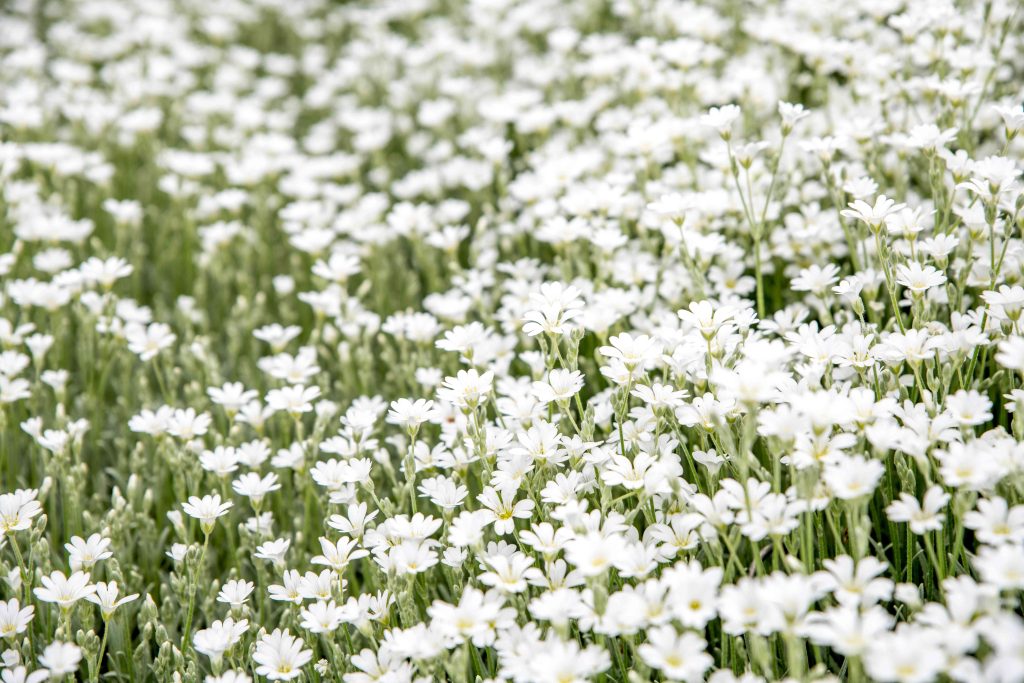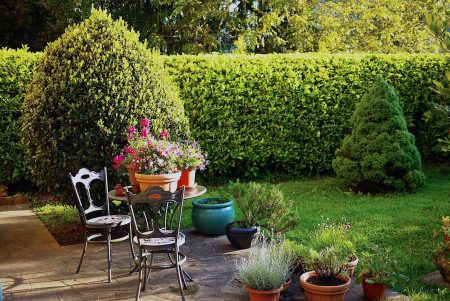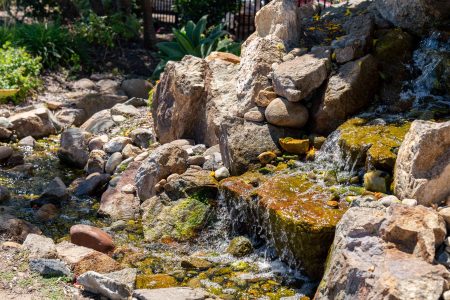“Moon gardens” are landscapes designed to make it possible for you to enjoy them at night, even without flooding your backyard with tons of artificial light. These gardens include plants with white flowers and silver or variegated foliage that can be seen in the reflected light from the moon. The best designs also include some fragrant plants that you can appreciate with your nose, making the garden romantic and mysterious. Light-colored hardscapes also work beautifully in a moon garden.
There are basically four types of plants (there will be some overlap) used in moon gardens:
- Plants with white flowers
- Plants with bright foliage
- Night bloomers
- Plants with fragrant blooms
While the use of a mass of color can have a great visual impact regardless of your landscape design theme, mass plantings are especially called for when planting moon gardens. A mass of white flowers has a more powerful impact than the same white flowers scattered about. Remember, you are looking for plants that show up at night; one blossom here and there will be swallowed up by the darkness.
White Flowers for Moon Gardens
The white flowers that will work in your moon garden will depend on your hardiness zone. Here, in our examples, we will consider how to create a moon garden in a more northern landscape, though there is certainly plenty for others to learn. The early bloomers will light up your yard in early-to-mid spring, after which they pass the baton to the mid-season bloomers. The latter can be supplemented with annuals. You’ll have to wait until late summer for the late bloomers, but they’re welcome reinforcements who will grant your moon garden a “second wind” when they do arrive.
Some of the plants on this list of white flowers come in colors other than white, too, but those with white flowers are preferred for nighttime viewing:
Early Bloomers for Moon Gardens
- Bulb plants, such as white daffodils (Narcissus) and white tulips (Tulipa)
- Creeping phlox (Phlox subulata)
- Bleeding heart (Dicentra eximia)
- Dwarf Fothergilla (Fothergilla gardenii)
- Azaleas and rhododendrons (Rhododendron spp.)
- Magnolia trees with white flowers, such as star magnolia (M. stellata)
Mid-Season Bloomers
- Yarrow (Achillea millefolium)
- Queen Anne’s lace (Daucus carota)
- Sweet alyssum (Lobularia maritima; treated as an annual in the North)
- Snow-in-summer (Cerastium tomentosum)
- Candytuft (Iberis sempervirens)
- Shasta daisy (Leucanthemum x superbum)
- Foxglove (Digitalis)
- Mountain laurel shrubs (Kalmia latifolia)
- Climbing hydrangea (Hydrangea anomala ssp. petiolaris)
- Japanese dogwood trees (Cornus kousa), including Wolf Eyes
- Doublefile viburnum (Viburnum plicatum var. tomentosum Mariesii)
- Slender Deutzia (Deutzia gracilis Nikko)
- Pearlbush (Exochorda racemosa)
Late Bloomers for Moon Gardens
- Mums (Chrysanthemum; pinch during summer to delay flowering)
- False dragonhead (Physostegia virginiana)
- Garden phlox (Phlox paniculata)
- Sweet autumn clematis (Clematis terniflora)
- Montauk daisy (Nipponanthemum nipponicum; pinch during summer to delay flowering)
- Moon flower vine (Ipomoea alba)
Don’t Forget Bright Leaves
While white-blooming flowers typically prevail in moon gardens, plants with bright foliage also work beautifully in moon gardens. One benefit of going the foliage route is low-maintenance, since leaves generally last longer than blossoms. Fragrant flowers also bring an extra sense into play and can be admired even on nights that are totally dark.
Plants whose bright leaves help them show up at night come in three categories and are among the best plants for moon gardens: specimens with variegated, gold-colored, and silver-colored leaves. The following list provides examples of each:
Plants With Bright Foliage for Moon Gardens
- Variegated dogwood bushes (Cornus alba Elegantissima)
- Variegated euonymus (Euonymus fortunei), including Moonshadow, Emerald ‘n’ Gold
- Japanese false cypress (Chamaecyparis Golden Mop)
- Lamb’s ear (Stachys byzantina; silver)
- Silver Mound artemisia (Artemisia schmidtiana Silvermound)
- Hosta (variegated, gold)
In the next two sections, plants that boast some of the most fragrant blossoms known are listed, beginning with the night bloomers (which must make use of scent, primarily, to lure in nighttime pollinators).
Click Play to Learn How to Select Night Blooming Plants for Moon Gardens
Night Bloomers
- Fragrant evening primrose (Oenothera speciosa)
- Angel’s trumpet (Brugmansia spp.; opens more fully at night, when it releases its amazing scent)
- Moonflower (Ipomoea alba)
Plants With Fragrant Blossoms
- Peonies (Paeonia lactiflora)
- Bearded iris (Iris germanica)
- Korean spice viburnum (Viburnum carlesii)
- Roses (Rosa spp.)
- Common lilac bushes (Syringa vulgaris)
- Easter lilies (Lilium longiflorum)
Read the full article here









